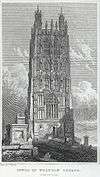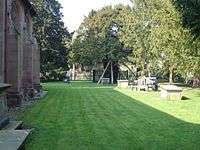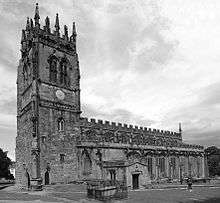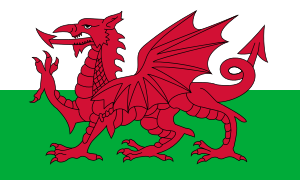Seven Wonders of Wales
This article is about Wales' Wonders. For other Seven Wonders, see Wonders of the World (disambiguation).

Snowdon
Pistyll Rhaeadr
Wrexham
Overton
St Winefride's Well
Llangollen
Gresford
The Seven Wonders of Wales
The Seven Wonders of Wales (Welsh: Saith Rhyfeddod Cymru) is a traditional list of notable landmarks in North Wales, commemorated in an anonymously written rhyme:
- Pistyll Rhaeadr and Wrexham steeple,
- Snowdon's mountain without its people,
- Overton yew trees, St Winefride's well,
- Llangollen bridge and Gresford bells.
The rhyme is usually supposed to have been written sometime in the late 18th or early 19th century by an English visitor to North Wales.[1] The specific number of wonders may have varied over the years: the antiquary Daines Barrington, in a letter written in 1770, refers to Llangollen Bridge as one of the "five wonders of Wales, though like the seven wonders of Dauphiny, they turn out to be no wonders at all out of the Principality".[2]
The seven wonders comprise:
| Image | Wonder | Location | Date | Notable Features |
|---|---|---|---|---|
| Pistyll Rhaeadr | Near Llanrhaeadr-ym-Mochnant, Powys | n/a | A tall waterfall, falling 240 ft (73 m) in three stages | |
 |
St Giles' Church Eglwys San Silyn |
Wrexham | 16th-century | The 16th-century tower of St Giles' Church in Wrexham can be seen for miles |
 |
Overton yew trees Coed ywen Owrtyn |
Overton-on-Dee, Wrexham County Borough | Planted at different times, ~3rd–12th century | 21 yew trees at St Mary's Church |
| St Winefride's Well Ffynnon Wenffrewi |
Holywell, Flintshire | AD 660 | Historically claimed to have healing waters | |
| |
Llangollen Bridge Pont Llangollen |
Llangollen, Denbighshire | 1347 | The first stone bridge to span the Dee |
 |
Gresford bells Clychau Gresffordd |
Gresford, Wrexham County Borough | 13th-century | The church bells are listed for their purity and tone |
 |
Snowdon Yr Wyddfa |
Snowdonia, Gwynedd | n/a | Highest mountain in Wales at 3,560 ft (1,085 m) |
Notes and references
- ↑ Wales on Britannia: Seven Wonders of Wales, britannia.com
- ↑ Letter to Mr. Gough, July 20, 1770, in Illustrations of the literary history of the eighteenth century, v.5, Nichols, Son, and Bentley, 1828, p.583
See also
This article is issued from Wikipedia - version of the 8/23/2016. The text is available under the Creative Commons Attribution/Share Alike but additional terms may apply for the media files.
